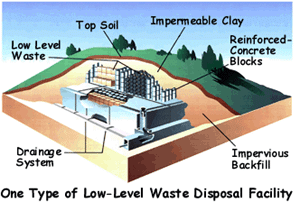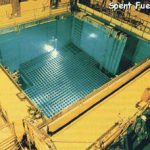Nuclear power plants generate two types of waste: high-level and low-level.
High-level waste includes the fuel that was used in the nuclear reactor, called “spent fuel.” It is highly radioactive and very dangerous. It must be cooled for several years in deep pools inside the plant, after which it can be transferred to special casks, which are like big, concrete barrels. Some of the fission products in the spent fuel will take many years to lose their radioactivity. A special disposal site is needed for this type of waste. In early 2012, a Blue Ribbon Commission of policy experts recommended creating one or more large facilities where the waste from several nuclear plants can be stored until a disposal site is found.

Low-level waste can come from nuclear reactors or from hospitals or universities. Low-level waste is not as dangerous as high-level waste. It can be shipped to low-level waste disposal facilities. There, it is packaged, buried in trenches and covered with soil. States are responsible for selecting new disposal sites or using those that already exist.
Nuclear power provides about 20 percent of our nation’s electricity. And nuclear materials help in thousands of medical procedures and dozens of industrial uses. But many scientists believe we haven’t yet found all the ways to use nuclear materials. The NRC will be closely regulating any peaceful use of nuclear material to protect public health and safety, and the world in which we live.
Source: http://www.nrc.gov/reading-rm/basic-ref/students.html


